Input interpretation

KOH potassium hydroxide + CaBr_2 calcium bromide ⟶ Ca(OH)_2 calcium hydroxide + KBr potassium bromide
Balanced equation
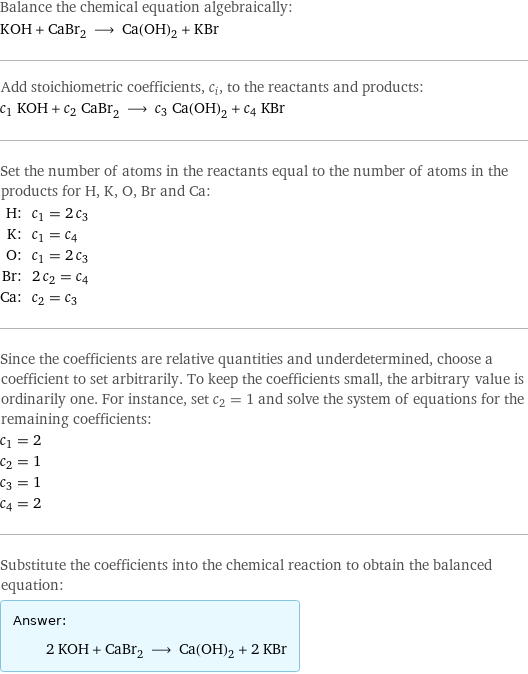
Balance the chemical equation algebraically: KOH + CaBr_2 ⟶ Ca(OH)_2 + KBr Add stoichiometric coefficients, c_i, to the reactants and products: c_1 KOH + c_2 CaBr_2 ⟶ c_3 Ca(OH)_2 + c_4 KBr Set the number of atoms in the reactants equal to the number of atoms in the products for H, K, O, Br and Ca: H: | c_1 = 2 c_3 K: | c_1 = c_4 O: | c_1 = 2 c_3 Br: | 2 c_2 = c_4 Ca: | c_2 = c_3 Since the coefficients are relative quantities and underdetermined, choose a coefficient to set arbitrarily. To keep the coefficients small, the arbitrary value is ordinarily one. For instance, set c_2 = 1 and solve the system of equations for the remaining coefficients: c_1 = 2 c_2 = 1 c_3 = 1 c_4 = 2 Substitute the coefficients into the chemical reaction to obtain the balanced equation: Answer: | | 2 KOH + CaBr_2 ⟶ Ca(OH)_2 + 2 KBr
Structures

+ ⟶ +
Names

potassium hydroxide + calcium bromide ⟶ calcium hydroxide + potassium bromide
Reaction thermodynamics
Enthalpy
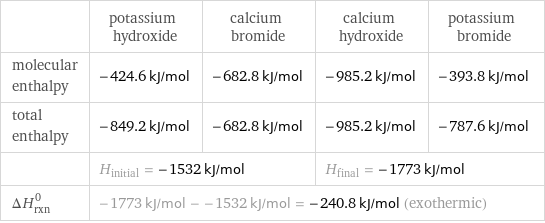
| potassium hydroxide | calcium bromide | calcium hydroxide | potassium bromide molecular enthalpy | -424.6 kJ/mol | -682.8 kJ/mol | -985.2 kJ/mol | -393.8 kJ/mol total enthalpy | -849.2 kJ/mol | -682.8 kJ/mol | -985.2 kJ/mol | -787.6 kJ/mol | H_initial = -1532 kJ/mol | | H_final = -1773 kJ/mol | ΔH_rxn^0 | -1773 kJ/mol - -1532 kJ/mol = -240.8 kJ/mol (exothermic) | | |
Gibbs free energy
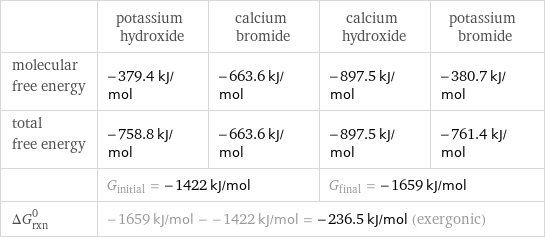
| potassium hydroxide | calcium bromide | calcium hydroxide | potassium bromide molecular free energy | -379.4 kJ/mol | -663.6 kJ/mol | -897.5 kJ/mol | -380.7 kJ/mol total free energy | -758.8 kJ/mol | -663.6 kJ/mol | -897.5 kJ/mol | -761.4 kJ/mol | G_initial = -1422 kJ/mol | | G_final = -1659 kJ/mol | ΔG_rxn^0 | -1659 kJ/mol - -1422 kJ/mol = -236.5 kJ/mol (exergonic) | | |
Equilibrium constant
![Construct the equilibrium constant, K, expression for: KOH + CaBr_2 ⟶ Ca(OH)_2 + KBr Plan: • Balance the chemical equation. • Determine the stoichiometric numbers. • Assemble the activity expression for each chemical species. • Use the activity expressions to build the equilibrium constant expression. Write the balanced chemical equation: 2 KOH + CaBr_2 ⟶ Ca(OH)_2 + 2 KBr Assign stoichiometric numbers, ν_i, using the stoichiometric coefficients, c_i, from the balanced chemical equation in the following manner: ν_i = -c_i for reactants and ν_i = c_i for products: chemical species | c_i | ν_i KOH | 2 | -2 CaBr_2 | 1 | -1 Ca(OH)_2 | 1 | 1 KBr | 2 | 2 Assemble the activity expressions accounting for the state of matter and ν_i: chemical species | c_i | ν_i | activity expression KOH | 2 | -2 | ([KOH])^(-2) CaBr_2 | 1 | -1 | ([CaBr2])^(-1) Ca(OH)_2 | 1 | 1 | [Ca(OH)2] KBr | 2 | 2 | ([KBr])^2 The equilibrium constant symbol in the concentration basis is: K_c Mulitply the activity expressions to arrive at the K_c expression: Answer: | | K_c = ([KOH])^(-2) ([CaBr2])^(-1) [Ca(OH)2] ([KBr])^2 = ([Ca(OH)2] ([KBr])^2)/(([KOH])^2 [CaBr2])](../image_source/0a48d0487fc300b12346d591f310867e.png)
Construct the equilibrium constant, K, expression for: KOH + CaBr_2 ⟶ Ca(OH)_2 + KBr Plan: • Balance the chemical equation. • Determine the stoichiometric numbers. • Assemble the activity expression for each chemical species. • Use the activity expressions to build the equilibrium constant expression. Write the balanced chemical equation: 2 KOH + CaBr_2 ⟶ Ca(OH)_2 + 2 KBr Assign stoichiometric numbers, ν_i, using the stoichiometric coefficients, c_i, from the balanced chemical equation in the following manner: ν_i = -c_i for reactants and ν_i = c_i for products: chemical species | c_i | ν_i KOH | 2 | -2 CaBr_2 | 1 | -1 Ca(OH)_2 | 1 | 1 KBr | 2 | 2 Assemble the activity expressions accounting for the state of matter and ν_i: chemical species | c_i | ν_i | activity expression KOH | 2 | -2 | ([KOH])^(-2) CaBr_2 | 1 | -1 | ([CaBr2])^(-1) Ca(OH)_2 | 1 | 1 | [Ca(OH)2] KBr | 2 | 2 | ([KBr])^2 The equilibrium constant symbol in the concentration basis is: K_c Mulitply the activity expressions to arrive at the K_c expression: Answer: | | K_c = ([KOH])^(-2) ([CaBr2])^(-1) [Ca(OH)2] ([KBr])^2 = ([Ca(OH)2] ([KBr])^2)/(([KOH])^2 [CaBr2])
Rate of reaction
![Construct the rate of reaction expression for: KOH + CaBr_2 ⟶ Ca(OH)_2 + KBr Plan: • Balance the chemical equation. • Determine the stoichiometric numbers. • Assemble the rate term for each chemical species. • Write the rate of reaction expression. Write the balanced chemical equation: 2 KOH + CaBr_2 ⟶ Ca(OH)_2 + 2 KBr Assign stoichiometric numbers, ν_i, using the stoichiometric coefficients, c_i, from the balanced chemical equation in the following manner: ν_i = -c_i for reactants and ν_i = c_i for products: chemical species | c_i | ν_i KOH | 2 | -2 CaBr_2 | 1 | -1 Ca(OH)_2 | 1 | 1 KBr | 2 | 2 The rate term for each chemical species, B_i, is 1/ν_i(Δ[B_i])/(Δt) where [B_i] is the amount concentration and t is time: chemical species | c_i | ν_i | rate term KOH | 2 | -2 | -1/2 (Δ[KOH])/(Δt) CaBr_2 | 1 | -1 | -(Δ[CaBr2])/(Δt) Ca(OH)_2 | 1 | 1 | (Δ[Ca(OH)2])/(Δt) KBr | 2 | 2 | 1/2 (Δ[KBr])/(Δt) (for infinitesimal rate of change, replace Δ with d) Set the rate terms equal to each other to arrive at the rate expression: Answer: | | rate = -1/2 (Δ[KOH])/(Δt) = -(Δ[CaBr2])/(Δt) = (Δ[Ca(OH)2])/(Δt) = 1/2 (Δ[KBr])/(Δt) (assuming constant volume and no accumulation of intermediates or side products)](../image_source/70e4da854fb607cebcf765696a716d3d.png)
Construct the rate of reaction expression for: KOH + CaBr_2 ⟶ Ca(OH)_2 + KBr Plan: • Balance the chemical equation. • Determine the stoichiometric numbers. • Assemble the rate term for each chemical species. • Write the rate of reaction expression. Write the balanced chemical equation: 2 KOH + CaBr_2 ⟶ Ca(OH)_2 + 2 KBr Assign stoichiometric numbers, ν_i, using the stoichiometric coefficients, c_i, from the balanced chemical equation in the following manner: ν_i = -c_i for reactants and ν_i = c_i for products: chemical species | c_i | ν_i KOH | 2 | -2 CaBr_2 | 1 | -1 Ca(OH)_2 | 1 | 1 KBr | 2 | 2 The rate term for each chemical species, B_i, is 1/ν_i(Δ[B_i])/(Δt) where [B_i] is the amount concentration and t is time: chemical species | c_i | ν_i | rate term KOH | 2 | -2 | -1/2 (Δ[KOH])/(Δt) CaBr_2 | 1 | -1 | -(Δ[CaBr2])/(Δt) Ca(OH)_2 | 1 | 1 | (Δ[Ca(OH)2])/(Δt) KBr | 2 | 2 | 1/2 (Δ[KBr])/(Δt) (for infinitesimal rate of change, replace Δ with d) Set the rate terms equal to each other to arrive at the rate expression: Answer: | | rate = -1/2 (Δ[KOH])/(Δt) = -(Δ[CaBr2])/(Δt) = (Δ[Ca(OH)2])/(Δt) = 1/2 (Δ[KBr])/(Δt) (assuming constant volume and no accumulation of intermediates or side products)
Chemical names and formulas
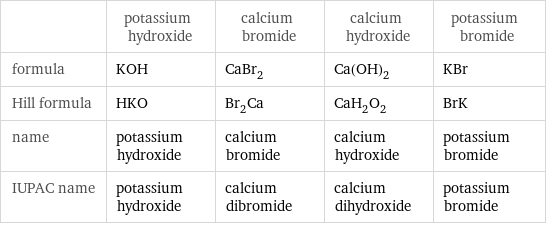
| potassium hydroxide | calcium bromide | calcium hydroxide | potassium bromide formula | KOH | CaBr_2 | Ca(OH)_2 | KBr Hill formula | HKO | Br_2Ca | CaH_2O_2 | BrK name | potassium hydroxide | calcium bromide | calcium hydroxide | potassium bromide IUPAC name | potassium hydroxide | calcium dibromide | calcium dihydroxide | potassium bromide
Substance properties
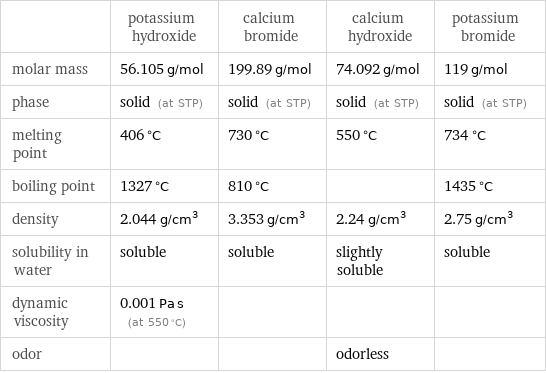
| potassium hydroxide | calcium bromide | calcium hydroxide | potassium bromide molar mass | 56.105 g/mol | 199.89 g/mol | 74.092 g/mol | 119 g/mol phase | solid (at STP) | solid (at STP) | solid (at STP) | solid (at STP) melting point | 406 °C | 730 °C | 550 °C | 734 °C boiling point | 1327 °C | 810 °C | | 1435 °C density | 2.044 g/cm^3 | 3.353 g/cm^3 | 2.24 g/cm^3 | 2.75 g/cm^3 solubility in water | soluble | soluble | slightly soluble | soluble dynamic viscosity | 0.001 Pa s (at 550 °C) | | | odor | | | odorless |
Units
